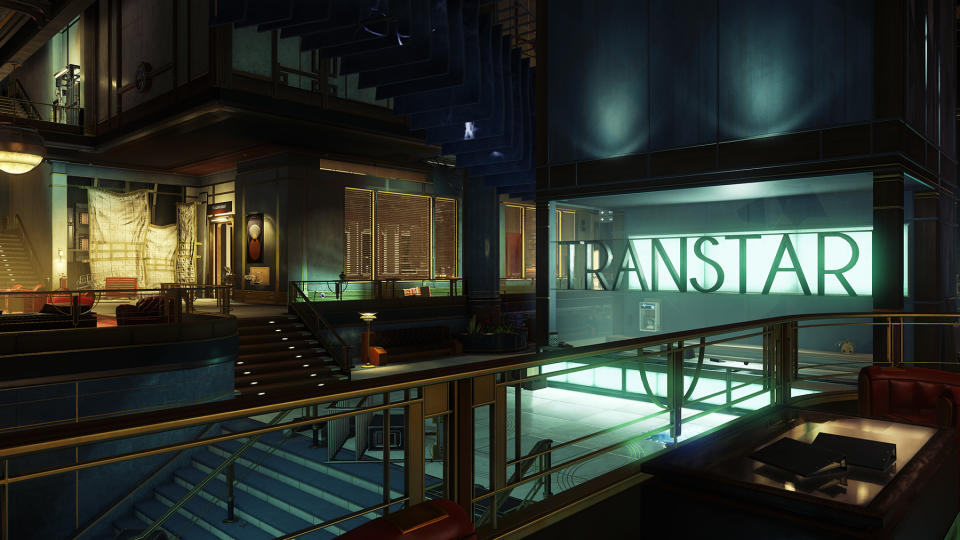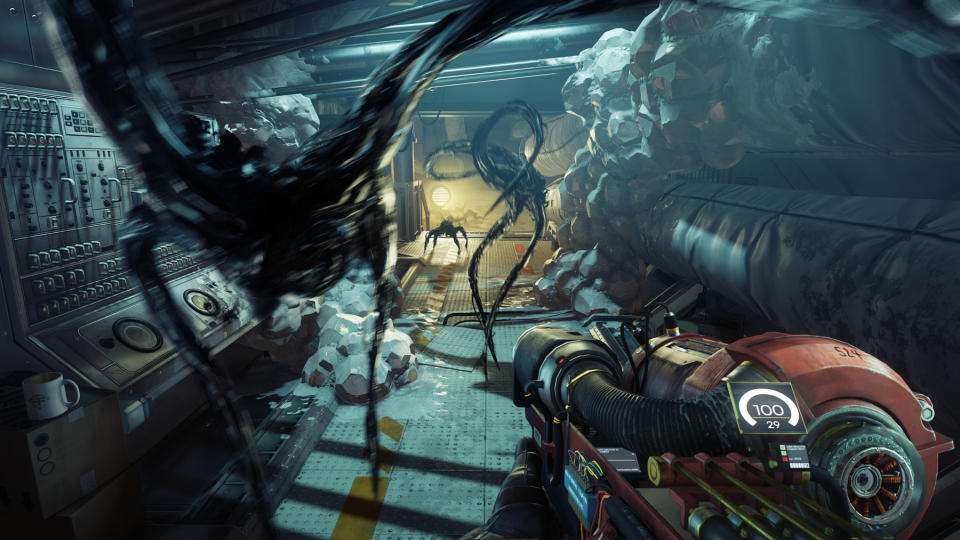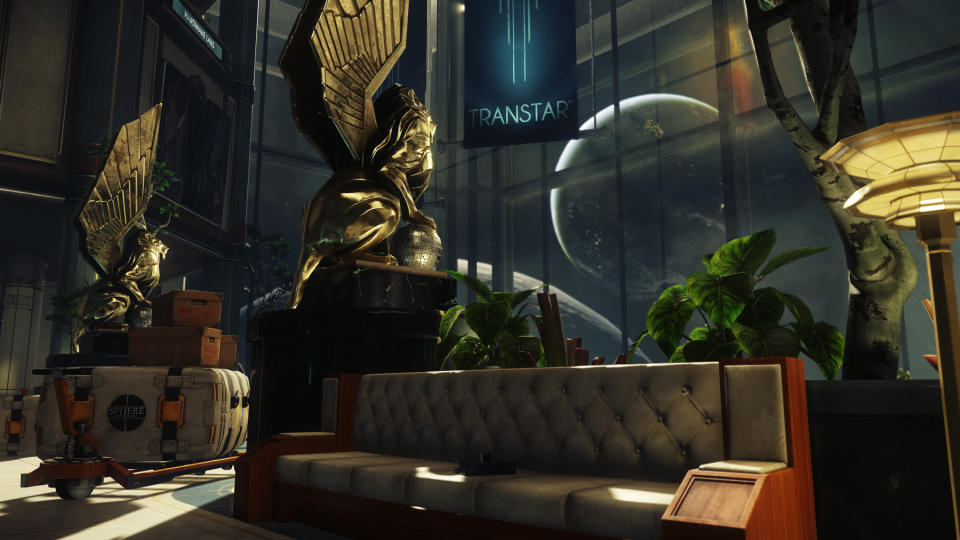How the studio behind 'Prey' reimagined space history
A different kind of sci-fi shooter.
Talos I is a beautiful nightmare. The privately-owned research facility, suspended in space above the Earth, offers a captivating blend of science and art-deco design. Its offices are filled with tall, geometric art prints, red leather sofas and mahogany desks laced with gold. The station's lobby, large and extravagant, features two winged-lion statues carved from bronze and a huge set of windows overlooking the Moon. It's gorgeous, but there's a problem — the vessel is overrun with black, wispy aliens that can hide in everyday objects and kill you in a couple of seconds.
Welcome to Prey, the latest video game from Arkane Studios.
While many developers have tried to tackle the "extraterrestrial discovery gone wrong" concept, few have done it with an alternate history running underneath. Talos I presents an intriguing future that is unlikely to materialize by 2035 — one where commercial companies, rather than government-funded organizations, run expensive science experiments in space. In the world of Prey, it's all possible because of a timeline that diverges from our own in the late 1950s. Piecing together this past is one of the most satisfying parts of the game. You're fighting not only to survive but to understand the people and political forces behind your situation.
(Note: This piece contains some mild story spoilers.)

Breaking the norm
Arkane's alternate history grew from a desire to break away from space-disaster norms. "We didn't want to do any kind of installation that was military or government," Ricardo Bare, Prey's lead designer said. "I feel like we've seen that a lot, and we just weren't as interested in that." Between Halo, Doom and even the most recent Call of Duty, the video-game industry is rife with uber-buff galactic soldiers. The focus on warfare leads to dropships and planet-side bases that are chock full of dark, oppressive metal. Experimentation and artistic flourishes are usually saved for the game's alien species.
Looking for a new direction, the team researched the original space race that kicked off between the United States and the Soviet Union in 1955. The first man-made satellite, Sputnik 1, was launched in 1957, followed by Sputnik 2, with the Soviet space dog Laika on board, a little more than a month later. A mad dash for space dominance followed, the two nations desperate to make history and outdo one another. Arkane wondered: What it would be like if cosmonauts discovered an alien race at this time? How would the two nations react?

"Now, secretly behind the scenes, the US and Soviet Union are collaborating rather than competing," Bare explains. "And the early kernel of the [Talos I] space station, called the Kletka, is actually a collaboration between the US and the Soviets to contain this alien organism."
During development, Sébastien Mitton, art director for Dishonored and Dishonored 2, visited the team in Texas to give some feedback and direction. He suggested that, in the game's universe, John F. Kennedy should survive his assassination in 1963. "I was like, 'Man, that fits with what we're doing really well. Let's go with that,'" Bare recalls. The idea became another crucial turning point in Prey's alternate history. If Kennedy survived, he might have had a greater influence on the space industry. Extra funding and government support would have fueled innovation, accelerating humanity's early efforts into the cosmos.
In Prey's timeline, the US and Soviet Union build Kletka to trap and observe the vicious "Typhon" alien threat. A company called Transtar eventually takes control of the project, expanding and transforming the ship for its own needs. The Kletka name vanishes, replaced by Talos I.
The privatization is a reflection of our current space industry. While NASA struggles to retain its funding, companies like SpaceX are stepping in with new ideas. Elon Musk's fearless startup is now delivering payloads to the International Space Station and learning how to land rockets so they can be cleaned up and used once more. "What happens to Elon Musk's company? What if he, or Google, or someone like that ... what would happen if they ... what would they look like in 100 years if they decided to build a space station? It certainly would not look like the ISS," Bare muses.

Keeping up appearances
The parts of Talos I built by Transtar have a distinctive, retro-futuristic look. They represent the company's wealth and lofty ideals, but also the impact of Kennedy, and how his extended reign as president affected architecture, fashion and interior design. Art-deco typography lifted from the 1920s and 30s stand out on station maps and laboratory signs. Wooden floorboards and overused ash trays permeate every office. It's a dark, decadent place, the kind The Great Gatsby might build if he woke up one day and suddenly decided to live in outer space.
Like everything in game development, it took time for Arkane to finesse this look. The team looked everywhere for "signature visual motifs" that embodied Kennedy and the early 1960s. A big source of inspiration was the Viceroy hotel in New York, near Central Park. While less than a decade old, the luxury tower borrows heavily from art deco culture, with guest rooms that resemble a tailored ship's cabin. "If you imagine the station was built by a company informed by that sort of aesthetic, but then also had some futuristic layerings on top of it — that's where we ended up," Bare explains.

Talos I is split into different sections, complete with science fiction names like Hardware Labs, Psychotronics and Deep Storage. Some, such as Crew Quarters, are designed for leisure, with a huge swimming pool and cafeteria close by. Others, like the Neuromod Division, are meant for scientific research, or day-today repairs on the ship. Wandering through the hallways and nosing around people's offices, it's easy to believe that this was, indeed, a working station where brilliant minds collaborated and lived together. There's a commitment to detail — everything, from bedside books to cluttered workstations, feels consistent and considered.
"Our approach is simple," Bare says, "everything in the world should have a reason for why it's there and why it looks the way that it looks." Take the gorgeous, geometric-art prints dotted around the station. A book later in the game reveals they're part of a series designed exclusively for Transtar by former street artist Patryk O. They all convey a space-centric theme, such as orbit and eclipse, through a mixture of circles and simple, deliberate line work. The posters symbolize the importance Transtar and its staff place in art, philosophy and risk-taking.
As you move deeper into the station, this elegance fades away. Talos I is like an onion with "layers" that span several decades. The core is the original Kletka station from the 1950s, all sparse and metal. The first laboratories were built by the US and the Soviet Union, and often feel like an old Russian submarine. The corridors are tighter, with exposed piping and hatches that lead to cramped ventilation shafts. Huge computers line the walls, crammed with physical buttons and switches. A needle dances from left to right on one of the readouts, while various red lights flicker on and off.

These older machines also feature in the modern facilities built by Transtar. Staff have modern, touchscreen monitors on their desks that you can use to peek at emails, transfer important files and, sometimes, find important employees on the ship. Beside them, however, you'll often find a dusty tape deck or a console that feels woefully archaic by comparison. That juxtaposition is intentional and, in some ways, historically accurate. Space travel is expensive and infrequent, which makes swapping out equipment difficult. If there's a use for something, it's better to keep it on board than waste precious cargo space shipping it back to Earth.
There's also the old phrase: If it ain't broke, don't fix it. NASA hardware can often look a bit chunky because, over several missions, it's proved to be reliable. It's why the International Space Station isn't filled with touchscreens or the latest Apple MacBooks.
A space to play
Talos I is more than an architectural marvel, however. The station has to serve the gameplay too, which falls into an awkwardly-named genre called "immersive sim." That means you can tackle foes and explore the spaceship in a variety of different ways. If a monster is blocking your path, you can shoot it in the face with a shotgun, hack a nearby turret, or avoid it completely by sneaking inside a ventilation shaft. All three strategies are equally viable, and experimentation is encouraged.

The open nature of Prey is augmented by Neuromods. These upgrades, which you adopt by shoving a needle in your eye, are at the center of Transtar's research. They grant incredible powers, such as superhuman strength and lightning-quick hacking, by quickly rewriting the brain. Partway through the game, you also gain access to Typhon-based Neuromods that let you shapeshift, control minds and launch devastating kinetic blasts. The Neuromods you enable, and how you use them to traverse Talos I is entirely your choice. A pacifist may focus on morphing to sneak their way past the enemy; a merciless hunter might invest in the "Electrostatic Burst" instead.
Talos I, then, needed to be a playground. The lobby, for example, with its high ceiling and central elevator, is a versatile battlefield at multiple points in the game. You can hide behind a sofa and set up some turrets, or run along the chain of marble glass panels that hang overhead, getting the drop on some unsuspecting Typhon. The space, then, serves two purposes — to be visually interesting, and facilitate dynamic combat encounters.
"We didn't want the player to feel claustrophobic or think the environments were repetitive," Bare says. "We still wanted big, open-feeling spaces. So that was a game-design constraint. Sometimes you have a fictional idea, and it informs how you want to build something, but sometimes you want to build something a certain way and then you look for a way to justify that fictionally. So that worked out the other way in this case."

Delivering the story
Arkane's alternate history is presented in a few different ways. The environments themselves tell a story — just walking through the garden-like Arboretum, for instance, will help you understand the breadth of research that was occurring onboard Talos I. Then there are the books, notes and "transcribe" audio memos dotted throughout every room. Some of them are personal, revealing heated arguments and bitter rivalries between employees. Others are insightful, explaining Transtar's influence and the public perception back on Earth. Reading and listening to them all will help you slowly piece together what's happened.
"It's sort of like ... I have this huge photograph, and every new thing I encounter and pick up increases the resolution of the photograph in my mind," Bare says. "That is, the picture in my mind of what this place is." Such a concept will be familiar to immersive sim fans. System Shock, BioShock and Deus Ex all feature rooms packed with written messages and note-to-self recordings. The more you read, look and listen, the more each game and its world come into focus.

Prey's use of environmental storytelling helps to counterbalance its game structure, which is neither linear nor nonlinear. Some missions are critical in order to complete the game, while others are optional and occasionally inaccessible depending on your actions. You can go (almost) wherever, whenever you like on Talos I, meaning how you uncover the central mystery and Arkane's alternate history is up to you. Some players, for instance, will find the museum early on and quickly piece together the Kennedy-era space program. Others will miss it completely, or only discover it 10, 20 or 30 hours later.
Every person's playthrough is different, which is both a blessing and a curse for Arkane. The freedom to explore makes your discoveries feel more personal, but on the flipside, they can be confusing or meaningless until you've found other, related pieces of correspondence on the ship. "My mental map of the story and the world might be totally different than yours because I didn't find that one character you found and rescued," Bare says. "Or I didn't read that one book. Or I didn't see that one poster. A lot of it is in the hands of the player versus me, as a level designer, trying to be an author and make sure that every single person experiences this one beat at this one time, and feels a certain way about it."
"We're totally OK with the player not seeing every beautiful, meticulous thing that we created."
There's a book, for example, written by an author called Lance B. Jenkins on the ship. An excerpt from the back cover praises the "alternate history novel" for its depiction of a Vietnam war: "But what if America had stood up for its allies in Vietnam? Would Communism still reign in the East? Would the Iron Curtain have fallen?" The insinuation, of course, is that the conflict never happened in Prey's timeline. Bare suspects that only 10 percent of players will find and read this blurb in the game.

Prey gambles on the player adopting the role of detective. You'll get the general gist if you blast through the mandatory story missions, but the subtleties of the ship and Arkane's alternate space race will probably wash over you. Bare doesn't mind, however. He says the freedom to examine or ignore people's possessions is what makes Talos I feel so real. "That's what I love about these kinds of games," he says, "and what makes them feel like worlds that are alive, versus worlds that are static. We're totally OK with the player not seeing every beautiful, meticulous thing that we created."
The game's alternate space race is easy to ignore. With a dozen deadly Typhon on your tail, it's understandable — sensible, even — to prioritize your health bar over haphazard exploration. To bury that curiosity, however, would be a disservice to the world that Arkane has created. Among its emails and art-deco furniture is a reality that feels both reflective and strangely prophetic about the future. What our space industry was, and could have grown into; what it's like now, and could be if privatization outstrips government interest. Let's just hope a race of conscious-sapping aliens isn't lurking amongst the stars.



























